Do Detail Drawing Have Hidden Lines
2 The Linguistic communication of Lines
- OBJECTLINE
- Hidden LINE
- SECTION LINE
- CENTER LINE
- DIMENSION LINE
- EXTENSION LINE
- LEADER LINE
- Cut Airplane LINE
- BREAK LINES
- PHANTOM LINES
- Border LINE
Yous have heard the proverb, "A picture is worth a thousand words". This statement is especially true in regards to technical drawings.
It would be most impossible for an engineer, designer, or architect to describe in words the shape, size, and relationship of a complex object. Therefore, drawings have become the universal linguistic communication used past engineers, designers, technicians, equally well every bit craftsmen, to communicate the Information necessary to build, assemble and service the products of industry.
It is Important to remember, equally you study Print Reading, that you are learning to communicate with the graphic language used by Industry: Lines are part of that language.
Since technical drawings are made of lines, it is logical that the kickoff stride in learning to "read" a drawing is to acquire the meaning of each kind of line. Mostly, there are 11 bones types of lines. Each kind of line has a definite form and "weight". Weight refers to line thickness or width. When combined in a drawing, lines provide function of the Information needed to understand the impress.
Being able to interpret a design and accurately build objects is a needed skill to get successful in all merchandise crafts. It is a skill, like many others you volition learn, and it volition take fourth dimension and exercise to fully empathise and become proficient.
Object Line
A visible line , or object line is a thick continuous line, used to outline the visible edges or contours of an object.

Subconscious Line
A hidden line , also known as a hidden object line is a medium weight line, made of short dashes nigh 1/8" long with 1/sixteen"gaps, to show edges, surfaces and corners which cannot exist seen. Sometimes they are used to brand a drawing easier to understand. Frequently they are omitted in an isometric view.

Section Line
Section lines are used to evidence the cut surfaces of an object in section views. They are fine, nighttime lines. Various types of section lines may betoken the type of cloth cutting past the cutting plane line.

Center Line
Center lines are used to indicate the centers of holes, arcs, and symmetrical objects. They are very thin (size), long-short-long kinds of lines.

Dimension Line
Dimension lines are thin and are used to show the actual size of an object. There are arrowheads at both end that terminate at the extension lines.

Extension Line
Extension lines are also thin lines, showing the limits of dimensions. Dimension line arrowheads bear upon extension lines.
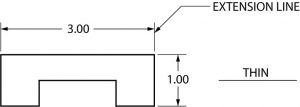
Leader Line
Leaders are more than thin lines used to point to an area of a drawing requiring a note for explanation. They are preferably drawn at a 45° angles.

Cut Plane Line
A cutting plane line (very heavy) helps to evidence the internal shape at a part or assembly by slicing through the object.
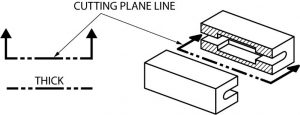
Break Line
There are iii kinds of break lines used in drawings. They are used to remove, or 'break out" part of a drawing for clarity, and likewise to shorten objects which have the same shape throughout their length and may be as well long to place on the cartoon.

Short and long break lines are used for apartment surfaces. Cylindrical are used on rods, dowels, etc.
Phantom Line
Phantom lines are long-short-curt-long lines most often used to evidence the travel or movement of an object or a role in alternate positions. Information technology can too be used to show side by side objects or features.

Border Line
Borderlines are very thick, continuous lines used to show the purlieus of the drawing or to dissever unlike objects fatigued on one canvass. They are also used to separate the title block form the rest of the drawing.
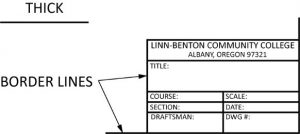
Quiz….
Directions: Proper name the types of lines shown below. Bank check your own answers
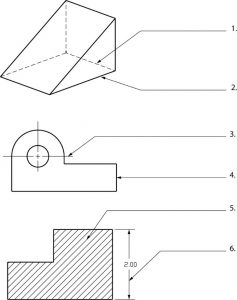

Identify the various line types used in this drawing. (instructor will provide a copy of this cartoon)
Name the types of lines shown beneath. Check your own answers.
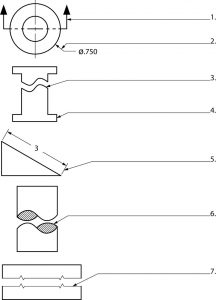
Directions: Draw and identify the lines needed to complete the figures every bit indicated.
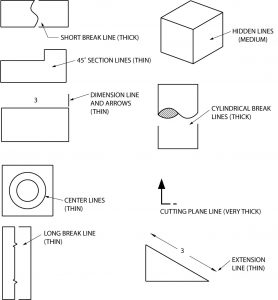
Source: https://openoregon.pressbooks.pub/blueprint/chapter/unit-1-the-language-of-lines/
Posted by: terrellsuaing.blogspot.com


0 Response to "Do Detail Drawing Have Hidden Lines"
Post a Comment